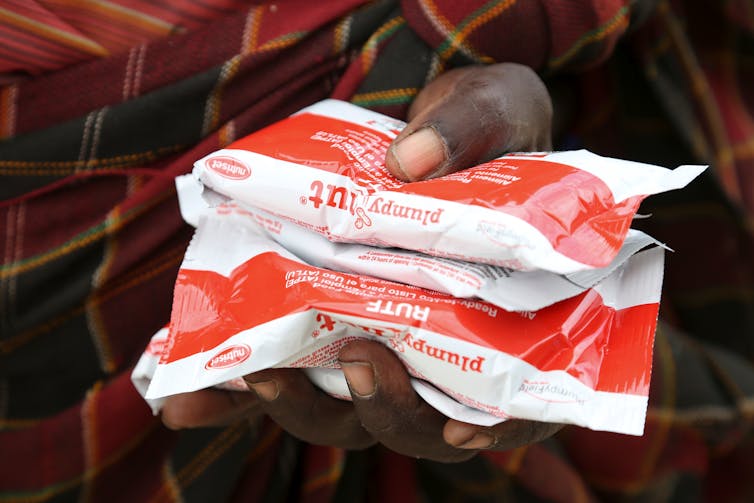Each year around the globe, 45 million children under the age of five experience wasting, which is very low body weight relative to height as a result of muscle and fat loss. Of these, 13.6 million have severe wasting, which puts them at an 11-fold risk of dying from infectious diseases compared to children who are not wasted.
Nutritional edema (also known as kwashiorkor) is another manifestation of malnutrition that often goes unmeasured in surveys. But it is likely that worldwide, hundreds of thousands of children per year have edema.
Children with edema have swelling in their feet at minimum, but their legs, hands, arms and faces can also become swollen. Researchers are still questioning why some children develop edema versus wasting — or a combination of the two.
Severe wasting and edema were previously called severe acute malnutrition, but this didn’t reflect the fact that children can have wasting for months at a time and can have repeated bouts of it after recovering.
Zero Hunger goals
The world is halfway to the end of the Sustainable Development Goals timeline, which includes ending all forms of malnutrition by 2030 as part of the Zero Hunger goal. This means dropping the rate of wasting to below five per cent by 2025 as an intermediate target and below three per cent by 2030 — which we are not on track to achieve.
The 2023 Global Report on Food Crises stated that 258 million people in 58 countries needed urgent food assistance in 2022. This is the highest number since the first report seven years prior. The report highlights that acute food insecurity can be attributed mainly to conflict, economic shocks and extreme weather from climate change.
As an expert in malnutrition, when I see these figures, I expect a rise in severe wasting and edema as a significant consequence. But the international nutrition community is active in trying to reach more children who need treatment and deliver care based on available evidence.
Treating severe wasting and edema
Malnutrition in the form of severe wasting and edema is a complex child health issue that requires specialized nutritional and medical treatment.
A majority of children with wasting or edema can be treated in outpatient settings, under a model called Community-Based Management of Acute Malnutrition that was backed by several United Nations agencies in 2007. Before this model, all children with severe wasting and edema were admitted to hospital.
Ready-to-use therapeutic food (RUTF) is a key part of this treatment of children in their communities. RUTF is designated as a “food for special medical purposes” for children with severe wasting and edema. It was added to the WHO Model List of Essential Medicines for Children in July 2023. This is seen as a huge achievement for many in the nutrition community because RUTF should be stocked like other important medicines, such as antibiotics, in places where wasting and edema occur. This could also help improve integration of nutrition into health systems.
RUTF is usually made of peanuts, oil, sugar and milk powder, with vitamins and minerals mixed in. These ingredients are squeezed into 500-calorie sachets that are shelf-stable for up to two years.
However, one in five children with severe wasting and edema needs to be admitted for hospital treatment at specialized centres called nutritional rehabilitation units (NRUs). These are extremely vulnerable children, suffering from this serious form of malnutrition in combination with co-morbidities like HIV or tuberculosis. Mortality rates in NRUs vary from 10 to 40 per cent.

When children are admitted to NRUs, health-care workers prioritize identifying and managing life-threatening conditions. The first phase of treatment, the stabilization phase, involves giving children a specific type of therapeutic milk known as F-75 — because it has 75 calories per 100 millilitres — every few hours along with breast milk for younger children.
F-75 is relatively low in calories and protein to lower the chance of refeeding syndrome. Refeeding syndrome occurs when food is consumed too quickly after starvation, causing serious shifts in electrolytes and fluids that can be fatal.
Once stabilized, children can transition to F-100 and/or RUTF while being treated in NRUs, at which point they start to regain weight. When children meet criteria that deems them healthy enough to leave the hospital, they continue with their treatment at home until they recover.
Global action and commitments
The current model of care has enabled treatment of most children with severe wasting and edema in their communities, apart from the sickest children who need NRU care. But still, two-thirds of children with severe wasting do not receive treatment, according to UNICEF.
UN partners announced the Global Action Plan (GAP) on Child Wasting in 2019, calling for a concerted global effort to tackle wasting and edema. In January 2023, they posted a call to action to protect children in 15 countries hit hard by the global food and nutrition crisis.
As part of the GAP, the WHO has released a new evidence-based guideline this year that covers the prevention of wasting and edema as well as management of:
- severe wasting and edema;
- moderate wasting (a less serious form of wasting than severe wasting that afflicts about 31 million children); and
- infants under six months old at risk of poor growth and development.
The previous WHO guideline was published a decade ago and only addressed treatment of severe wasting and edema.
There is also substantial financial support to reach more children with severe wasting and edema, such as a combined half a billion U.S. dollars commitment last year from donors and governments to address wasting, including $56 million from Canada.
And many countries affected by wasting and edema have made major commitments to update policies and accelerate wasting and edema management and prevention, with funds from national budgets earmarked for these actions.
The combination of political and financial actions that strengthen nutrition programs within health systems and reach more children with wasting and edema who need treatment will mean more children survive. New global guidance on how best to prevent and manage wasting will help to improve the care of these children.
But it needs to be all hands on deck — within and beyond the global nutrition community — to curtail the surge in wasting and edema in the highest risk children.
Allison Daniel is involved in the WHO guideline on prevention and management of wasting and nutritional edema, but the views in this article do not necessarily reflect those of WHO.
This article was originally published on The Conversation. Read the original article.







